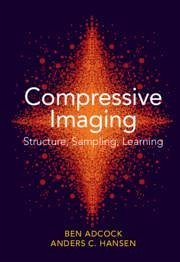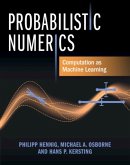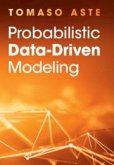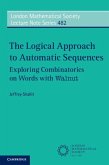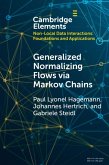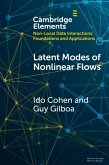Ben Adcock (British Columbia Simon Fraser University), Anders C. Hansen (University of Cambridge)
Compressive Imaging: Structure, Sampling, Learning
Ben Adcock (British Columbia Simon Fraser University), Anders C. Hansen (University of Cambridge)
Compressive Imaging: Structure, Sampling, Learning
- Gebundenes Buch
- Merkliste
- Auf die Merkliste
- Bewerten Bewerten
- Teilen
- Produkt teilen
- Produkterinnerung
- Produkterinnerung
This book provides a practical introduction to compressive imaging (with examples and code), an overview of core topics, and a comprehensive, rigorous treatment of the subject. It caters to graduate students, postdocs and faculty in mathematics, computer science, physics and engineering who want to learn about modern imaging techniques.
Andere Kunden interessierten sich auch für
![The Student's Introduction to Mathematica and the Wolfram Language The Student's Introduction to Mathematica and the Wolfram Language]() Bruce F. Torrence (Virginia Randolph-Macon College)The Student's Introduction to Mathematica and the Wolfram Language71,99 €
Bruce F. Torrence (Virginia Randolph-Macon College)The Student's Introduction to Mathematica and the Wolfram Language71,99 €![Probabilistic Numerics Probabilistic Numerics]() Philipp Hennig (Germany Eberhard-Karls-Universitat Tubingen)Probabilistic Numerics82,99 €
Philipp Hennig (Germany Eberhard-Karls-Universitat Tubingen)Probabilistic Numerics82,99 €![Probabilistic Data-Driven Modeling Probabilistic Data-Driven Modeling]() Tomaso Aste (University College London)Probabilistic Data-Driven Modeling94,99 €
Tomaso Aste (University College London)Probabilistic Data-Driven Modeling94,99 €![The Logical Approach to Automatic Sequences The Logical Approach to Automatic Sequences]() Jeffrey Shallit (Ontario University of Waterloo)The Logical Approach to Automatic Sequences86,99 €
Jeffrey Shallit (Ontario University of Waterloo)The Logical Approach to Automatic Sequences86,99 €![The Art of Inpainting The Art of Inpainting]() Simone Parisotto (Cambridge Fitzwilliam Museum)The Art of Inpainting90,99 €
Simone Parisotto (Cambridge Fitzwilliam Museum)The Art of Inpainting90,99 €![Generalized Normalizing Flows Via Markov Chains Generalized Normalizing Flows Via Markov Chains]() Paul Lyonel Hagemann (Technische Universitat Berlin)Generalized Normalizing Flows Via Markov Chains22,99 €
Paul Lyonel Hagemann (Technische Universitat Berlin)Generalized Normalizing Flows Via Markov Chains22,99 €![Latent Modes of Nonlinear Flows Latent Modes of Nonlinear Flows]() Ido Cohen (Technion - Israel Institute of Technology)Latent Modes of Nonlinear Flows22,99 €
Ido Cohen (Technion - Israel Institute of Technology)Latent Modes of Nonlinear Flows22,99 €-
-
-
This book provides a practical introduction to compressive imaging (with examples and code), an overview of core topics, and a comprehensive, rigorous treatment of the subject. It caters to graduate students, postdocs and faculty in mathematics, computer science, physics and engineering who want to learn about modern imaging techniques.
Produktdetails
- Produktdetails
- Verlag: Cambridge University Press
- Seitenzahl: 614
- Erscheinungstermin: 16. September 2021
- Englisch
- Abmessung: 252mm x 178mm x 34mm
- Gewicht: 1332g
- ISBN-13: 9781108421614
- ISBN-10: 110842161X
- Artikelnr.: 60891550
- Herstellerkennzeichnung
- Libri GmbH
- Europaallee 1
- 36244 Bad Hersfeld
- gpsr@libri.de
- Verlag: Cambridge University Press
- Seitenzahl: 614
- Erscheinungstermin: 16. September 2021
- Englisch
- Abmessung: 252mm x 178mm x 34mm
- Gewicht: 1332g
- ISBN-13: 9781108421614
- ISBN-10: 110842161X
- Artikelnr.: 60891550
- Herstellerkennzeichnung
- Libri GmbH
- Europaallee 1
- 36244 Bad Hersfeld
- gpsr@libri.de
Ben Adcock is Associate Professor of Mathematics at Simon Fraser University. He received the CAIMS/PIMS Early Career Award (2017), an Alfred P. Sloan Research Fellowship (2015) and a Leslie Fox Prize in Numerical Analysis (2011). He has published fifteen conference proceedings, two book chapters and over fifty peer-reviewed journal articles. His work has been published in outlets such as SIAM Review and Proceedings of the National Academy of Sciences, and featured on the cover of SIAM News.
1. Introduction
Part I. The Essentials of Compressive Imaging: 2. Images, transforms and sampling
3. A short guide to compressive imaging
4. Techniques for enhancing performance
Part II. Compressed Sensing, Optimization and Wavelets: 5. An introduction to conventional compressed sensing
6. The LASSO and its cousins
7. Optimization for compressed sensing
8. Analysis of optimization algorithms
9. Wavelets
10. A taste of wavelet approximation theory
Part III. Compressed Sensing with Local Structure: 11. From global to local
12. Local structure and nonuniform recovery
13. Local structure and uniform recovery
14. Infinite-dimensional compressed sensing
Part IV. Compressed Sensing for Imaging: 15. Sampling strategies for compressive imaging
16. Recovery guarantees for wavelet-based compressive imaging
17. Total variation minimization
Part V. From Compressed Sensing to Deep Learning: 18. Neural networks and deep learning
19. Deep learning for compressive imaging
20. Accuracy and stability of deep learning for compressive imaging
21. Stable and accurate neural networks for compressive imaging
22. Epilogue
Appendices: A. Linear Algebra
B. Functional analysis
C. Probability
D. Convex analysis and convex optimization
E. Fourier transforms and series
F. Properties of Walsh functions and the Walsh transform
Notation
Abbreviations
References
Index.
Part I. The Essentials of Compressive Imaging: 2. Images, transforms and sampling
3. A short guide to compressive imaging
4. Techniques for enhancing performance
Part II. Compressed Sensing, Optimization and Wavelets: 5. An introduction to conventional compressed sensing
6. The LASSO and its cousins
7. Optimization for compressed sensing
8. Analysis of optimization algorithms
9. Wavelets
10. A taste of wavelet approximation theory
Part III. Compressed Sensing with Local Structure: 11. From global to local
12. Local structure and nonuniform recovery
13. Local structure and uniform recovery
14. Infinite-dimensional compressed sensing
Part IV. Compressed Sensing for Imaging: 15. Sampling strategies for compressive imaging
16. Recovery guarantees for wavelet-based compressive imaging
17. Total variation minimization
Part V. From Compressed Sensing to Deep Learning: 18. Neural networks and deep learning
19. Deep learning for compressive imaging
20. Accuracy and stability of deep learning for compressive imaging
21. Stable and accurate neural networks for compressive imaging
22. Epilogue
Appendices: A. Linear Algebra
B. Functional analysis
C. Probability
D. Convex analysis and convex optimization
E. Fourier transforms and series
F. Properties of Walsh functions and the Walsh transform
Notation
Abbreviations
References
Index.
1. Introduction
Part I. The Essentials of Compressive Imaging: 2. Images, transforms and sampling
3. A short guide to compressive imaging
4. Techniques for enhancing performance
Part II. Compressed Sensing, Optimization and Wavelets: 5. An introduction to conventional compressed sensing
6. The LASSO and its cousins
7. Optimization for compressed sensing
8. Analysis of optimization algorithms
9. Wavelets
10. A taste of wavelet approximation theory
Part III. Compressed Sensing with Local Structure: 11. From global to local
12. Local structure and nonuniform recovery
13. Local structure and uniform recovery
14. Infinite-dimensional compressed sensing
Part IV. Compressed Sensing for Imaging: 15. Sampling strategies for compressive imaging
16. Recovery guarantees for wavelet-based compressive imaging
17. Total variation minimization
Part V. From Compressed Sensing to Deep Learning: 18. Neural networks and deep learning
19. Deep learning for compressive imaging
20. Accuracy and stability of deep learning for compressive imaging
21. Stable and accurate neural networks for compressive imaging
22. Epilogue
Appendices: A. Linear Algebra
B. Functional analysis
C. Probability
D. Convex analysis and convex optimization
E. Fourier transforms and series
F. Properties of Walsh functions and the Walsh transform
Notation
Abbreviations
References
Index.
Part I. The Essentials of Compressive Imaging: 2. Images, transforms and sampling
3. A short guide to compressive imaging
4. Techniques for enhancing performance
Part II. Compressed Sensing, Optimization and Wavelets: 5. An introduction to conventional compressed sensing
6. The LASSO and its cousins
7. Optimization for compressed sensing
8. Analysis of optimization algorithms
9. Wavelets
10. A taste of wavelet approximation theory
Part III. Compressed Sensing with Local Structure: 11. From global to local
12. Local structure and nonuniform recovery
13. Local structure and uniform recovery
14. Infinite-dimensional compressed sensing
Part IV. Compressed Sensing for Imaging: 15. Sampling strategies for compressive imaging
16. Recovery guarantees for wavelet-based compressive imaging
17. Total variation minimization
Part V. From Compressed Sensing to Deep Learning: 18. Neural networks and deep learning
19. Deep learning for compressive imaging
20. Accuracy and stability of deep learning for compressive imaging
21. Stable and accurate neural networks for compressive imaging
22. Epilogue
Appendices: A. Linear Algebra
B. Functional analysis
C. Probability
D. Convex analysis and convex optimization
E. Fourier transforms and series
F. Properties of Walsh functions and the Walsh transform
Notation
Abbreviations
References
Index.

